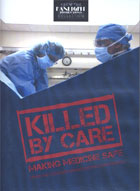
Killed by Care 2004
Distributed by Icarus Films, 32 Court St., 21st Floor, Brooklyn, NY 11201; 800-876-1710
Producer n/a
Directed by Daniel Zuckerbrot
DVD, color, 45 min.
Sr. High-General Adult
Health Sciences, Death and Dying, Ethics
Date Entered: 08/03/2012
Reviewed by Charles J. Greenberg, Cushing/Whitney Medical Library, Yale UniversityThe 1999 Institute of Medicine (IOM) report To Err is Human: Building a Safer Health System (free PDF available) served as a U.S. wake-up call to the problems of medical mistakes. At that time the Committee on Quality of Health Care in America authoring the report estimated that up to 98,000 Americans die of medical mistakes every year. These were patients who did not meet the end of life because of disease or illness, but by the systems designed to treat their problem. Subsequently, in December 2000 the U.S. Agency for Healthcare Research and Quality (AHRQ) appropriated $50 million to support a variety of programs aimed at reducing medical errors. Now, after more than 10 years, and in spite of physician and hospital ratings like Health Grades® and the rise of Evidence-Based Practice for health professions, the 1999 IOM report is still considered the best comprehensive analysis of an unacceptable and persistent crisis in health care.
The documentary Killed by Care is certainly a worthy companion and successor to the IOM report. Killed by Care was originally produced in 2004 for the Canadian Broadcast Corporation (CBC), five years after the IOM report. This timely film had all the advantages of an emerging mass of documentation and the initial outcomes of funded research into medical mistakes. The CBC chose one of the most trusted media figures in Canada, the science broadcaster and environmental activist, David Suzuki and his show, The Nature of Things, to present both a Canadian and American health problem. There are obvious geographic, cultural, and healthcare education and training links between the two countries.
A human story begins the film, an image of a newborn infant and a Canadian mother, Danica Terziski, who calmly narrates her son’s brief life that ended after heart surgery. Ms. Terziski also describes her realization that a newspaper article eight months later was describing her son’s demise, along with 11 other infants in a similar circumstance. Narrator Suzuki then introduces the show episode with the stark reminder that 10,000-24,000 Canadian patients are dying in medical culture of “secrecy and blame,” in spite of the health care mantra to “do no harm.” Visually engaging stock footage of hospitals and operating rooms accompanies the narration. Viewers then plunge into the shadows of health care blame and secrecy narrated by patients, physicians, nurses, and health policy experts.
Two members of the Committee on Quality of Health Care in America that produced the To Err is Human report are in fact the first two experts that comment for the film audience. Donald Berwick MD MPP, at that time a professor of pediatrics and health policy at Harvard Medical School, reveals to the audience that medical errors are killing more people annually than AIDS, motor vehicle accidents, or breast cancer. Lucien Leape MD from the Harvard School of Public Health notes on camera that while a risk of perishing in an airplane accident are one in three million, patients in an acute care hospital have a risk of one in three hundred to die from a medical error. Yet air crashes receive comprehensive investigations to establish causality and prevent future occurrences…medical errors usually do not.
An American anesthesiologist narrates his own mistake and the serious life-threatening consequence for a patient, and then we get to meet the patient, Linda Kenney, who talks about how her initial wave of anger was replaced by a need for closure, leading to a dramatic meeting with the physician and an offer of forgiveness. The physician himself describes how his hospital administration was more concerned about liability than the patient’s health. Kenney herself goes on to start a foundation called Medically Induced Trauma Support Service (MITSS) to advocate for disclosure, apology, and support in the aftermath of adverse medical events, as well as counseling support for nurses caught in the middle between patient advocacy and hospital liability concerns.
Back in the Canadian city of Winnipeg, an applicant for a new executive position of Hospital Safety Officer relates his own experience with the misdiagnosis and death of his own two-year old daughter. A medical team accepted an out-of-town diagnosis and fitted therapy to that, even when some symptoms didn’t quite fit. Viewers learn that when a care team thinks it knows the problem, patients are often left out of the conversation and ignored.
The health policy experts and narrator Suzuki contribute comments throughout the film to reinforce the idea that there is no simple solution. Many types of health care interventions are needed to create a culture of trust, listening, continuing medical education, and holding situations accountable, not blaming individuals. The innovation of simulated patients that offer unlimited learning and practice without risk or blame is briefly examined. Near the end of the film, Berwick says anger at the situation is useful, but only if it is brought to bear on things like communication, procedures, and documentation of errors. Two of the women from the film, Danica Terziski that lost her son, and Linda Kenney that forgave her anesthesiologist and chose not to seek damages in court, close the film by talking about how individuals can make a difference, and how individuals united can make change. MITSS is now ten years old and thriving.
As a film expressly made for a national and international television audience, editing and other essential production values are well done. A mixed audience of health practitioners and patients could use this film as a discussion trigger if the topic is how to fix a health care system or allow patients to become part of the solution.
Killed by Care is highly recommended for all public, academic, and high school audiences.